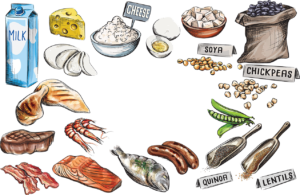 Protein is an essential macronutrient—the building block of the human body— and it is in every one of our cells. Protein is needed in the body to repair cells and make new ones; allow key biochemical reactions to take place; act as a messenger between cells, tissues, and organs; provide strength and structure to various parts of the body; maintain fluids; maintain the immune system; provide energy; and transport and store nutrients. In short, we can’t survive without protein.1 The current US Food and Nutrition Board’s Recommended Dietary Allowance (RDA) of protein for adult men and women is 0.8 grams per kilogram of body weight a day (g/kg/d).2 But research is showing that as we age, our protein requirements increase. Increased protein intake can prevent or mitigate the onset of sarcopenia, a term used to describe loss of muscle mass, strength, and function that progressively occurs with aging, which in turn can help an elderly individual maintain independence and have better overall quality of life and health.3,4
Protein is an essential macronutrient—the building block of the human body— and it is in every one of our cells. Protein is needed in the body to repair cells and make new ones; allow key biochemical reactions to take place; act as a messenger between cells, tissues, and organs; provide strength and structure to various parts of the body; maintain fluids; maintain the immune system; provide energy; and transport and store nutrients. In short, we can’t survive without protein.1 The current US Food and Nutrition Board’s Recommended Dietary Allowance (RDA) of protein for adult men and women is 0.8 grams per kilogram of body weight a day (g/kg/d).2 But research is showing that as we age, our protein requirements increase. Increased protein intake can prevent or mitigate the onset of sarcopenia, a term used to describe loss of muscle mass, strength, and function that progressively occurs with aging, which in turn can help an elderly individual maintain independence and have better overall quality of life and health.3,4
Experts in the field of protein and aging recommend a protein intake between 1.2 and 2.0g/kg/d or higher for elderly adults; this is much higher than the Food and Nutrition Board’s RDA of 0.8g/kg/d for adults. The recommended increase in protein intake for elderly adults is based on several studies showing that elderly adults are responsive (in improved muscle mass) to the higher levels of protein intake, but not lower levels.3 One meta-analysis showed that elderly individuals (mean age of 73 years) with sarcopenia consumed significantly less protein than their peers with no sarcopenia.4 A 2019 meta-analysis examining the link between low protein intake and functional limitations among the aging showed that individuals across all age groups who didn’t meet the protein intake recommendation encountered more physical limitations in stooping, crouching or kneeling; standing or sitting for long periods; walking up 10 steps; preparing meals, and walking for a quarter mile, compared to those who did meet the protein recommendation. Individuals aged 51–60 years old who did not meet the recommended protein intake had more difficulty sitting for long periods; getting in and out of bed; preparing meals; performing leisure activities at home; using a fork and knife; and drinking from a cup, compared to those who consumed higher protein amounts—this group’s limitations were similar to those of the 71 years of age or older group.5
According to a review article published in the journal Nutrients, it is important to consider overall caloric intake when considering protein intake for elderly individuals. According to these researchers, our basal metabolic rate (BMR) decreases as we age, which is associated with decreased muscle mass and increased fat mass, suggesting that our caloric intake should decrease as we age. This should be considered when choosing protein sources to include in one’s diet. These authors state, “When the energy content of the protein source is accounted for, the caloric intake needed to meet the essential amino acid requirements from plant sources of protein is considerably higher than the caloric intake from animal sources of protein. This is important to consider since obesity, especially with aging, is a major public health concern. Obesity is the most predominant factor limiting mobility in the elderly.”3
High Protein, Low-fat Foods to Add to Your Diet
The following foods are good sources of protein without a lot of fat:6
- White-fleshed fish (e.g., cod, haddock, grouper, halibut, bass, tilapia
- Plain nonfat Greek yogurt
- Beans, peas, and lentils
- Skinless white-meat poultry
- Low-fat cottage cheese
- Tofu
- Skim milk (nonfat)
- Pork loin
- Shrimp
- Egg whites
Editor’s Note
Please consult with your physician or a certified dietitian/nutritionist to determine the right amount of protein you need in your diet.
Sources
1. Van De Walle G. 9 important functions of protein in your body. 15 Feb 2023. Healthline website. https://www.healthline.com/nutrition/functions-of-protein#TOC_TITLE_HDR_9. Accessed 15 Mar 2023.
2. Food and Nutrition Board. Dietary Reference Intakes (DRI) for energy, carbohydrate, fiber, fat, fatty acids, cholesterol, protein, and amino acids. Institute of Medicine of the National Academies. Washington, DC: National Academies Press. 2005;589.
3. Baum JI, Kim IY, Wolfe RR. Protein consumption and the elderly: what is the optimal level of intake? Nutrients. 2016; 8(6):359.
4. Coelho-Junior HJ, Calvani R, Azzolino D, et al. Protein intake and sarcopenia in older adults: a systematic review and meta-analysis. Int J Environ Res Public Health. 2022;19(14):8718.
5. Krok-Schoen JL, Archdeacon Price A, Luo M, et al. Low dietary protein intakes and associated dietary patterns and functional limitations in an aging population: a NHANES analysis. J Nutr Health Aging. 2019;23:338–347.
6. DiGiacinto J, McCulloch M. Top 13 lean protein foods. 22 Feb 2023. Healthline website. https://www.healthline.com/nutrition/lean-protein-foods. Accessed 15 Mar 2023.





